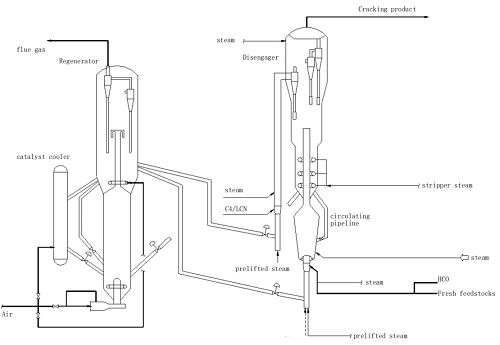I. Introduction
1. Background
In order to respond to the market structural changes and to maximize refinery margin, converting low-value residue into fuel oil and petrochemical feedstocks is an effective solution for refineries to realize efficient utilization of petroleum resources. Sinopec Research Institute of Petroleum Processing Co. Ltd. has developed a fluidized bed reactor with a unique structure and reaction characteristics, capable of converting low-quality heavy oil into petrochemicals. This innovation forms the basis of an innovative catalytic cracking technology of Reside to Chemicals (RTC). The RTC process converts low-quality heavy oil into ethylene, propylene, and BTX, providing flexible technical solutions for the transition from oil refining to the chemical industry.
2. Process scheme
The flow scheme of RTC process is similar to that of conventional FCC process, consisting of reaction-regeneration, fractionation, as well as absorption and stabilization sections, as shown in Figure 1.
After preheating, heavy oil is dispersed with steam and fed into the bottom of a fast fluidized bed reactor, where it interacts with hot regenerated catalyst to facilitate the catalytic reaction. The reactor effluent sequentially enters main fractionator and gas plant for product separation and recovery. The catalyst, which has coke deposited, is stripped with steam and then transferred to the regenerator, where air is introduced to remove the coke through combustion. The hot regenerated catalyst is returned to the reactor and provides the heat required for the reactions, achieving heat balance in the reactor-regenerator circulation.

Fig 1. Flow scheme of RTC process
3. Key equipment and operating parameters
The comparison between the RTC process and the conventional FCC process regarding main equipment and operating parameters is provided in Table 1.
The RTC process flow is similar to that of the conventional catalytic cracking (FCC) process, with main equipment including the reactor, regenerator, and main fractionator, gas plant and other treating facilities. The specially designed fast fluidized bed reactor is the core equipment of the RTC process, which acts as the site for heavy oil cracking. Optionally, a secondary riser reactor can be installed for processing light oils, including C4 hydrocarbons, light naphtha, coker naphtha, and hydrotreated light cycle oil, etc. The regenerator and regeneration process of the RTC process are similar to those of the conventional FCC process. However, due to the higher gas yield in the RTC process, the main fractionator requires a higher gas-to-liquid ratio. This also necessitates gas compressors with greater capacity, along with larger stabilization and absorption section.
The RTC process typically operates under relatively severe reaction conditions, including higher reaction temperature and a higher oil-to-catalyst ratio, as well as longer residence time. These conditions ensure that the cracked naphtha undergoes secondary reactions to produce light olefins. The amount of reaction steam injected is higher than that used in the FCC process. Additionally, the lower hydrocarbon partial pressure enhances the olefin concentration in the gas while reducing coke formation, which is favorable to light olefins production.

II. Technology characteristics
1. Unique reactor structure
RTC process utilizes a uniquely designed fast fluidized bed reactor, which enhances the uniform of temperature and catalyst concentration within the reactor, improves efficiency of gas-solid contact, and increases the selectivity of the catalytic reactions.
2. Products flexibility
RTC process offers high flexibility in product patterns, allowing for a quick switch between different operation modes based on market demand. It can flexibly switched between petrochemicals mode for maximizing light olefins and high BTX outputs and gasoline mode for producing more high RON gasoline, with light olefins as by products.
In the petrochemicals mode of the RTC process, the ethylene yield is up to 4%–5%, propylene yield can reach as high as 16%–20%and the gasoline fraction yield is at the range of 24%–28% (with light aromatics (BTX) accounting for approximately 6%–8%). In the gasoline mode, the propylene yield ranges from 12% to 15%, while the gasoline fraction yield is between 35% and 36%, with the total yield of liquefied gas and gasoline exceeding 70%.
3. Feedstock adaptability
RTC is capable of processing heavy oils, including VGO, AR, and HT-VR, especially for intermediate-based hydrotreated residue. The specifications of the RTC feedstock are shown in Table 2.

4. Proprietary catalyst
By employing a modified macroporous matrix with weak BrÖnsted acids, the diffusion of intermediate products is facilitated. Additionally, the use of hierarchical porous RMPZ zeolite and small crystal size ultra-stable Y zeolite enhances the accessibility of the catalyst active sites. The proprietary catalyst is featured by promoting the pre-cracking of the matrix, improving the accessibility of the active sites and the selectivity of light olefins. The specifications of the RTC catalysts are shown in Table 3.

5. Running cycle
RTC process employs a specialized separator that integrates the fast fluidized bed and disengagement systems to achieve rapid separation of hydrocarbons and catalyst. This design allows for the quick termination of reactions, reducing coke formation in both reactor and disengager. Additionally, the turnaround cycle for the RTC unit can be as long as four years, comparable to that of conventional FCC units.
6. Environmental benefits
RTC achieves lower energy consumption and lower CO2 emissions (carbon emissions of the process) compared to existing processes, contributing to a more sustainable and environmentally friendly operation.
III. Commercial Experience
Six RTC units have been licensed in China, with a total capacity of 17.4 million tons per annum (MTA). The first commercial RTC unit, with a capacity of 3,000 KTA, was put into operation in June 2023. Additionally, two more RTC units are going to put on stream by the end of 2024, while the other units are currently under design and construction. Furthermore, three projects are in the feasibility study stage.

